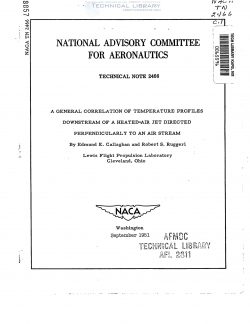naca-tn-2466
- Version
- 47 Downloads
- 1.03 MB File Size
- 1 File Count
- December 15, 2016 Create Date
- December 15, 2016 Last Updated
A General Correlation of Temperature Profiles

An experimental investigation was conducted to determine the tem-
perature profile downstream of a heated-air jet directed perpendicularly
to an air stream. The profiles were determined at several positions
downstream of the jet as functions of jet density, jet velocity, free-
stream density, free-stream velocity, jet temperature, and. orifice flow
coefficient.
A method is presented which yields a good approximation of the tem-
perature profile in terms of dimensionless parameters of the flow and
geometric conditions.
The heating of an air stream by means of an air jet directed per-
pendicularly to the air stream is reported in references 1 and 2. These
investigations were conducted to determine the penetration of a jet into
the air stream at various downstream positions as a function of the jet
and stream-flow conditions and of the size and shape of the orifices
from which the jet issued. The practical application of such a heating
system requires a knowledge of the temperature profile at any point
downstream of the orifice as well as the penetration of the jet into
the air stream.
An investigation was therefore conducted in a 2- by 20—inch tunnel
at the NACA Lewis laboratory to determine the temperature profile in
the plane of a jet at several positions downstream of a jet directed
perpendicularly to an air stream. Four heated air jets were investi-
gated for a range of free-stream velocities, jet total temperatures,
and jet total pressures.
The orifices used in the investigation were circular thin-plate
orifices with diameters of 0.250, 0.585, 0.500, and 0.625 inch. Each
orifice was investigated over a range of pressure ratios (ratio of Jet
total pressure to outlet static pressure) from 1.20 to 3.70 for Jet
total temperatures of approximately 200°, 300°, and 4000 F at free-
stream velocities of 180, 275, and 590 feet per second. Air for the
Jets was obtained by passing high-pressure air through an electric
heater and into a plenum chamber, the upper wall of which contained the
orifices as shown in figure 1.
| File | Action |
|---|---|
| naca-tn-2466 A General Correlation of Temperature Profiles.pdf | Download |

Comment On This Post